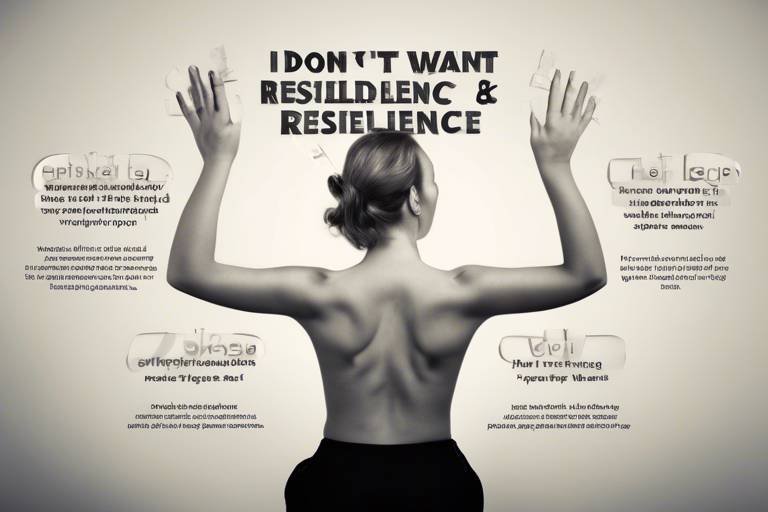Confidence Building Exercises - 10 Techniques to Try
Building self-confidence is a journey that can significantly enhance your life, both personally and professionally. It’s like planting a seed; with the right care and attention, it can grow into a strong, flourishing tree. This article explores ten effective techniques for building self-confidence, providing practical exercises that anyone can incorporate into their daily routine. Whether you're looking to boost your self-esteem before a big presentation or simply want to feel more secure in your daily interactions, these techniques can help you on your path to personal growth.
So, what exactly is confidence? At its core, confidence is the belief in your abilities and judgment. It's that inner voice that tells you, "You can do this!" Confidence is crucial in our personal and professional lives; it influences our decisions, shapes our interactions, and even affects our mental health. Think of it as the foundation of a house—without a solid base, everything else can crumble. When you exude confidence, you not only feel better about yourself, but you also inspire trust and respect from those around you. This section delves into the importance of confidence and how it can be your greatest ally in navigating life’s challenges.
Have you ever noticed how a positive mindset can change your entire day? Positive thinking is a powerful tool in building confidence, allowing you to overcome obstacles and tackle challenges head-on. It’s all about shifting your perspective and reframing negative thoughts into constructive ones. For instance, instead of thinking, "I can't do this," try telling yourself, "I can learn how to do this." By cultivating a positive mindset, you can break free from the chains of self-doubt and embrace your potential.
One of the most effective ways to reinforce positive beliefs is through affirmations. These are simple yet powerful statements that can help you challenge and overcome negative thoughts. For example, saying "I am capable and strong" can shift your mindset and boost your self-esteem. The beauty of affirmations lies in their simplicity; they can be tailored to fit your personal goals and aspirations. Let’s look at some tips for creating effective affirmations:
- Make them personal: Use "I" statements that resonate with you.
- Keep them positive: Focus on what you want to achieve, not what you want to avoid.
- Be specific: The more detailed, the better!
Integrating daily affirmation practices into your morning routine can significantly enhance your confidence. Imagine starting your day by looking in the mirror and declaring your worth. It’s like giving yourself a pep talk that sets the tone for the entire day. You can write your affirmations on sticky notes and place them on your bathroom mirror or repeat them during your morning coffee. The key is consistency; the more you repeat these affirmations, the more they will resonate within you.
Self-doubt can be a sneaky little monster that creeps in when you least expect it. However, by using affirmations, you can combat these negative thoughts effectively. Whenever you catch yourself spiraling into doubt, counter those thoughts with empowering statements. For example, if you think, "I’m not good enough," replace it with, "I am learning and growing every day." This technique not only transforms your mindset but also builds resilience against future doubts.
Another powerful technique for building confidence is visualization. Picture this: you’re standing in front of an audience, delivering a presentation, and you can see yourself succeeding. Visualization is about mentally rehearsing success, which can significantly impact your performance and self-assurance. By visualizing your goals and the steps to achieve them, you create a mental roadmap that guides you toward success. This method is often used by athletes and performers to enhance their skills and confidence.
Setting realistic and achievable goals is crucial for building confidence. Think of goals as stepping stones on your path to success. Each small win you achieve boosts your confidence and motivates you to tackle the next challenge. When you set goals, you not only give yourself direction but also a sense of purpose. It’s essential to break larger goals into smaller, manageable tasks that you can celebrate along the way.
The SMART criteria can help you set effective goals. SMART stands for Specific, Measurable, Achievable, Relevant, and Time-bound. Here’s a quick breakdown:
| SMART Criteria | Description |
|---|---|
| Specific | Clearly define what you want to achieve. |
| Measurable | Determine how you will measure your progress. |
| Achievable | Ensure your goal is realistic and attainable. |
| Relevant | Make sure your goal aligns with your values and long-term objectives. |
| Time-bound | Set a deadline for your goal to create urgency. |
Recognizing and celebrating small achievements can greatly boost your confidence. It’s like throwing a mini-party for yourself every time you reach a milestone. Whether it’s completing a task or overcoming a fear, acknowledging your progress keeps you motivated and reinforces your self-worth. Find ways to reward yourself—maybe treat yourself to a favorite snack or take a moment to reflect on your journey. Remember, every small win is a step closer to your larger goals!
Q: How long does it take to build self-confidence?
A: Building self-confidence is a personal journey that varies for everyone. With consistent practice and the right techniques, you can start seeing improvements in a few weeks.
Q: Can I build confidence in specific areas, like public speaking?
A: Absolutely! By using targeted techniques like visualization and practice, you can build confidence in specific skills.
Q: What if I struggle with negative thoughts?
A: It’s normal to have negative thoughts, but using affirmations and positive thinking can help you manage and overcome them.

Understanding Confidence
Confidence is more than just a buzzword; it's a cornerstone of personal and professional success. Think about it: when you walk into a room filled with people, your level of confidence can dictate how you interact with others, how you present your ideas, and even how you perceive your own value. But what exactly is confidence? At its core, confidence is the belief in one’s ability to succeed. It’s that inner voice that says, “I can do this!” rather than “What if I fail?” This belief is not just about feeling good; it's about taking action and embracing opportunities.
In our daily lives, confidence plays a crucial role in shaping our decisions and interactions. For instance, consider a job interview scenario. A confident candidate is likely to make a strong impression, articulate their thoughts clearly, and engage with the interviewer effectively. On the other hand, a lack of confidence can lead to missed opportunities, as self-doubt can overshadow our abilities and potential. It’s like trying to swim with weights tied to your ankles; no matter how skilled you are, those weights will hold you back.
Confidence is not a fixed trait; it can be developed and nurtured over time. By understanding the factors that contribute to confidence, we can start to build a more robust sense of self. Here are some key components that influence confidence:
- Self-awareness: Knowing your strengths and weaknesses helps you to navigate challenges more effectively.
- Experience: The more you face challenges and succeed, the more your confidence grows.
- Support from others: Encouragement from friends, family, or mentors can significantly boost your self-belief.
Moreover, confidence is not just about how we feel internally; it also affects how others perceive us. A confident person often commands attention and respect, while someone who appears uncertain might struggle to make their voice heard. This interplay between self-perception and external perception creates a cycle: the more confident you feel, the more likely you are to act confidently, and the more others will respond positively to you.
In summary, understanding confidence is essential for anyone looking to improve their self-esteem and personal growth. It serves as the foundation for taking risks, pursuing goals, and ultimately achieving success. So, whether you're looking to excel in your career, improve your relationships, or simply feel better about yourself, building confidence is a crucial step on that journey.

The Power of Positive Thinking
Have you ever noticed how your thoughts can shape your reality? Positive thinking is like a superpower that can transform your life in ways you might not expect. It’s not just about wearing rose-colored glasses; it’s about cultivating a mindset that fosters growth, resilience, and confidence. When you embrace a positive outlook, you’re not only improving your mood but also enhancing your ability to tackle challenges head-on. Think of it as the difference between driving a car with a clear windshield versus one that’s fogged up. Which one would you prefer when navigating through life’s twists and turns?
One of the most significant impacts of positive thinking is its ability to boost self-confidence. When you believe in your abilities and maintain an optimistic view, you're more likely to take risks and pursue opportunities. This doesn’t mean ignoring reality or pretending everything is perfect; rather, it’s about focusing on solutions instead of problems. Here are a few strategies to cultivate a positive mindset:
- Practice gratitude—acknowledge the good things in your life.
- Surround yourself with positive influences—people who uplift and inspire you.
- Engage in self-reflection—identify negative thought patterns and challenge them.
By actively working on these strategies, you’ll find that your self-talk transforms from a critical inner voice to one that encourages and supports you. This shift is crucial in overcoming the barriers that self-doubt creates. Remember, the mind is a powerful tool; what you feed it will determine your confidence level.
Now, let’s dive deeper into one of the most effective tools for promoting positive thinking: affirmations. These are simple, positive statements that can help you challenge and overcome negative thoughts. For instance, instead of saying, "I can’t do this," try affirming, "I am capable and strong." The beauty of affirmations lies in their ability to rewire your brain, reinforcing positive beliefs about yourself.
Incorporating daily affirmation practices can significantly enhance your confidence. Consider starting your day with a few minutes dedicated to affirmations. You could write them down in a journal or say them out loud in front of a mirror. This practice not only sets a positive tone for your day but also gradually builds your self-esteem. The more you repeat these statements, the more they become ingrained in your mind, leading to a more confident you.
Using affirmations to combat self-doubt is a game-changer. When those nagging thoughts creep in, reminding you of your limitations, counter them with empowering statements. For example, if you find yourself thinking, "I’m not good enough," replace it with, "I am worthy of success and happiness." It’s like having a mental toolkit ready to dismantle negativity whenever it arises. Over time, this practice can transform your internal dialogue, making it more supportive and encouraging.
In conclusion, the power of positive thinking is undeniable. By actively working to cultivate a positive mindset through techniques like affirmations and gratitude, you can significantly boost your self-confidence. Remember, every little step counts! As you embark on this journey of self-discovery and empowerment, keep in mind that you are capable of achieving great things. So, why not start today?
Q1: How long does it take to see results from positive thinking?
A1: The timeline varies for everyone, but many people notice changes in their mindset and confidence within a few weeks of consistent practice.
Q2: Can positive thinking really change my life?
A2: Yes! Positive thinking can enhance your resilience, improve your relationships, and open up new opportunities in both personal and professional aspects of life.
Q3: What if I struggle to stay positive?
A3: It’s normal to have ups and downs. If you find it challenging, consider seeking support from friends, family, or even a mental health professional.

Affirmations
Affirmations are more than just positive phrases; they are powerful tools that can reshape our thoughts and beliefs. When we repeat affirmations, we are essentially planting seeds of positivity in our minds, which can lead to a flourishing garden of self-confidence. Imagine your mind as a canvas, and affirmations are the vibrant colors that bring your self-image to life. By consciously choosing what we tell ourselves, we can counteract the negativity that often creeps in and holds us back.
To get started with affirmations, it's essential to craft statements that resonate with you personally. These should be in the present tense, positive, and specific. For example, instead of saying, “I will be confident,” try “I am confident and capable.” This subtle shift in wording can make a significant difference in how your brain processes the statement. The more you repeat these affirmations, the more your subconscious mind believes them, leading to a boost in self-esteem and a more positive outlook on life.
Here are some effective examples of affirmations you can use:
- I am worthy of love and respect.
- I believe in my abilities and skills.
- I am capable of achieving my goals.
- I embrace challenges as opportunities for growth.
Incorporating affirmations into your daily routine can enhance their effectiveness. You might choose to recite them in the morning while getting ready for the day or write them down in a journal. The key is consistency. Just like exercising to build physical strength, regularly practicing affirmations can strengthen your mental resilience. Consider setting aside a few minutes each day to focus on your affirmations, allowing them to sink in and become a part of your daily mindset.
Moreover, overcoming doubts with affirmations can be incredibly empowering. When negative thoughts arise, you can counter them with your affirmations. For instance, if you catch yourself thinking, “I can’t do this,” replace that thought with, “I have the skills and determination to succeed.” This practice not only helps in combating self-doubt but also reinforces a cycle of positivity that fosters growth.
In conclusion, affirmations are a simple yet profound way to build self-confidence. By consciously choosing positive statements and integrating them into your life, you can transform your mindset and pave the way for personal growth. Remember, just like any skill, the more you practice affirmations, the more natural they will become, leading to a more confident and empowered you.
Q1: How long does it take for affirmations to work?
A1: The time it takes for affirmations to work can vary from person to person. With consistent practice, many people start to notice positive changes in their mindset within a few weeks.
Q2: Can I create my own affirmations?
A2: Absolutely! Creating your own affirmations that resonate with your personal experiences and goals is encouraged. Tailoring them to fit your life will make them more impactful.
Q3: Should I say affirmations out loud or in my head?
A3: Both methods can be effective. Saying affirmations out loud can enhance their impact, but repeating them silently in your mind can also be beneficial, especially in situations where you may feel uncomfortable speaking them aloud.
Q4: How many affirmations should I use?
A4: Focus on a few key affirmations that resonate with you the most. It's better to deeply connect with a small number than to overwhelm yourself with too many at once.

Daily Affirmation Practices
Incorporating into your routine can be a game-changer for your self-confidence. Just imagine waking up each morning, looking in the mirror, and reminding yourself of your worth and capabilities. It’s like giving your inner critic a much-needed vacation while you bask in the glow of positivity! But how do you make affirmations a part of your daily life? Let’s dive in.
First off, it’s essential to choose the right time for your affirmations. Many people find that practicing affirmations in the morning sets a positive tone for the day, while others prefer to do it at night to reflect on the day’s events. The key is consistency. Whether it’s during your morning coffee or right before bed, find a time that works for you and stick to it. This ritual not only reinforces your positive beliefs but also creates a sense of routine that can be incredibly grounding.
Next, let’s talk about the environment. Create a space that feels good to you. This could be a cozy corner in your room, a peaceful spot in your garden, or even a quiet moment in your car. Surround yourself with things that inspire you—perhaps a vision board, uplifting quotes, or calming scents. This positive environment can amplify the effectiveness of your affirmations.
When crafting your affirmations, ensure they resonate with you personally. Instead of generic phrases, tailor them to your specific goals and desires. For example, instead of saying, “I am confident,” you might say, “I embrace challenges with confidence and grace.” This personalization makes your affirmations much more impactful. Here are some tips for creating effective affirmations:
- Be Present: Use the present tense to affirm your beliefs, as if they are already true.
- Keep It Positive: Frame your statements positively. Focus on what you want, not what you want to avoid.
- Be Specific: The more specific your affirmation, the more powerful it can be.
Another powerful technique is to combine your affirmations with visualization. As you recite your affirmations, close your eyes and visualize yourself embodying those statements. Feel the emotions associated with your success—joy, pride, and confidence. This mental imagery can create a strong connection between your affirmations and your subconscious mind, making them more effective.
Finally, don’t underestimate the power of repetition. Just like learning a new skill, the more you practice your affirmations, the more they will stick. Consider writing them down in a journal or displaying them on sticky notes around your home. This way, you’ll be reminded of your affirmations throughout the day, reinforcing the positive messages you’re sending to yourself.
In summary, making daily affirmations a part of your life can significantly boost your confidence and help you overcome self-doubt. By choosing the right time, creating a positive environment, personalizing your affirmations, visualizing success, and practicing regularly, you can transform your mindset and embrace a more confident version of yourself. Remember, confidence is not just a trait you’re born with; it’s something you can cultivate through consistent practice and belief in yourself.
Q: How long should I practice affirmations each day?
A: Ideally, spend at least 5-10 minutes each day on affirmations. Consistency is key!
Q: Can I use affirmations for specific goals?
A: Absolutely! Tailor your affirmations to align with your personal or professional goals for maximum impact.
Q: What if I don’t believe my affirmations at first?
A: That’s completely normal! With time and repetition, your subconscious will begin to accept these positive statements.

Overcoming Doubts with Affirmations
Let’s face it: we all have those moments when self-doubt creeps in, whispering negative thoughts that can derail our confidence. It’s like having a pesky mosquito buzzing around your head, distracting you from enjoying a beautiful day. But fear not! Affirmations are here to help you swat those doubts away and reclaim your self-assurance.
At its core, an affirmation is a positive statement that can help you challenge and control negative thoughts. By repeating affirmations, you can start to shift your mindset from one of self-doubt to one of empowerment. Imagine your mind as a garden; when you plant positive seeds, you cultivate a flourishing landscape of confidence. Conversely, if you allow weeds of doubt to take root, they can choke out your self-esteem. So, how can you effectively use affirmations to overcome doubts?
First off, be specific with your affirmations. Instead of saying, “I am confident,” try something more personalized like, “I confidently express my ideas in meetings.” This specificity makes your affirmations more relatable and easier to visualize. When you say it, picture yourself in that meeting, confidently sharing your thoughts. This mental imagery reinforces the belief that you can indeed be that person.
Additionally, it’s vital to incorporate affirmations into your daily routine. Consider creating a morning ritual where you say your affirmations out loud while looking in the mirror. This practice not only sets a positive tone for your day but also helps you internalize these powerful statements. You might even want to write them down and place them in visible spots around your home or workspace, serving as constant reminders of your worth.
Another effective technique is to use affirmations to transform negative self-talk. When you catch yourself thinking, “I can’t do this,” counter it with a strong affirmation like, “I have the skills and determination to succeed.” This practice is like having a superhero cape; it empowers you to rise above the negativity and reclaim your confidence. Remember, the more you practice, the stronger your belief in these affirmations will become.
To illustrate the power of affirmations, let’s take a look at a simple table that compares negative thoughts with their corresponding affirmations:
| Negative Thought | Affirmation |
|---|---|
| I am not good enough. | I am capable and worthy of success. |
| I always mess things up. | I learn and grow from my experiences. |
| No one will listen to me. | My voice is valuable and deserves to be heard. |
By actively replacing negative thoughts with affirmations, you can create a powerful shift in your mindset. It’s a bit like tuning a guitar; when you adjust the strings, the music becomes harmonious. Similarly, when you adjust your thoughts, your life can resonate with confidence and positivity.
In conclusion, overcoming doubts with affirmations is not just about repeating words; it’s about embodying the essence of those statements. It’s about believing in your potential and embracing the journey of self-discovery. So, the next time self-doubt tries to sneak in, remember to arm yourself with affirmations and watch how your confidence flourishes!
- What are affirmations? Affirmations are positive statements that help challenge and control negative thoughts.
- How often should I practice affirmations? Daily practice is recommended, especially during your morning routine to set a positive tone for the day.
- Can affirmations really change my mindset? Yes! Regularly repeating affirmations can help shift your mindset from self-doubt to self-empowerment.
- What if I don't believe my affirmations at first? It's normal! With consistent practice, your belief in these affirmations will grow over time.

Visualization Techniques
Visualization techniques are not just for athletes or performers; they are powerful tools that anyone can use to enhance their self-confidence. Imagine your mind as a canvas, and with every visualization, you are painting a picture of success and achievement. This mental imagery can significantly impact your performance and self-assurance in various situations, whether it’s a job interview, a presentation, or even a social gathering. When you visualize success, you are essentially rehearsing it in your mind, which can lead to improved outcomes in real life.
One of the most effective ways to utilize visualization is to create a clear and vivid mental image of your goals. Picture yourself achieving what you desire, whether it's acing an exam, giving a stellar speech, or even simply walking confidently into a room full of people. The more detailed your visualization, the more powerful it becomes. Engage all your senses: what do you see, hear, and feel in that moment of success? This sensory engagement helps to solidify the experience in your mind, making it feel more real and attainable.
To get started with visualization, you can follow these simple steps:
- Find a Quiet Space: Choose a comfortable and quiet place where you can relax without distractions.
- Close Your Eyes: Take a few deep breaths to calm your mind and body.
- Visualize Your Success: Picture yourself achieving your goal in vivid detail. Imagine the setting, the people around you, and the emotions you feel.
- Repeat Regularly: Make visualization a daily practice. The more you visualize, the more ingrained the positive images become in your mind.
Moreover, studies have shown that visualization can lead to real changes in brain activity and can improve performance. It’s like a mental rehearsal that prepares you for the actual event. Just as athletes visualize their performances before competitions, you can apply the same technique to your personal and professional life. The brain doesn’t distinguish between real experiences and vividly imagined ones, which means that by visualizing success, you’re training your mind to believe in your abilities.
Additionally, if you find it challenging to visualize on your own, consider using guided visualization techniques available through various apps or online resources. These tools can provide you with structured guidance and help you immerse yourself in the process. Remember, the key is consistency. The more you practice visualization, the more natural it will become, and the more confident you will feel when facing challenges.
In conclusion, visualization is a powerful technique that can help you build confidence and achieve your goals. By regularly picturing your success and engaging your senses in the process, you can create a mental environment that fosters self-assurance and a positive mindset. So, why not give it a try? You might be surprised by how much of a difference it can make in your life!
1. What is visualization?
Visualization is a mental technique that involves creating vivid images in your mind to achieve specific goals or outcomes. It helps in preparing mentally for various situations, enhancing performance and confidence.
2. How often should I practice visualization?
For best results, it’s recommended to practice visualization daily. Just a few minutes each day can significantly enhance your confidence and help you achieve your goals.
3. Can visualization really improve my performance?
Yes! Studies have shown that visualization can lead to improved performance in various fields, including sports, public speaking, and even daily tasks. It prepares your mind for success.
4. Do I need to be an expert to visualize effectively?
Not at all! Visualization is a skill that anyone can learn. Start simple, and with practice, you will become more adept at creating vivid and effective mental images.

Setting Achievable Goals
Setting realistic and achievable goals is not just a fancy motivational quote; it’s a fundamental step in building your self-confidence. Think of your goals as the stepping stones on a path to personal growth. When you set goals that are within reach, you not only create a roadmap for your journey but also give yourself the opportunity to experience small victories along the way. These victories are crucial because they reinforce your belief in your abilities and encourage you to push further. Imagine trying to climb a mountain without a clear path; it would feel overwhelming and daunting, right? But with each small summit you reach, your confidence grows, and you feel more equipped to tackle the next challenge.
To effectively set achievable goals, it’s important to consider the SMART criteria. This acronym stands for Specific, Measurable, Achievable, Relevant, and Time-bound. Let’s break this down:
| SMART Criteria | Description |
|---|---|
| Specific | Your goal should be clear and specific, so you know exactly what you're aiming for. |
| Measurable | Include criteria to measure your progress and success, ensuring you can track your achievements. |
| Achievable | Your goal should be realistic and attainable, considering your current resources and constraints. |
| Relevant | Ensure your goal aligns with your broader objectives and values, making it meaningful to you. |
| Time-bound | Set a deadline for your goal to create a sense of urgency and keep you focused. |
By applying the SMART criteria, you can create goals that not only inspire you but also feel manageable. For instance, instead of saying, “I want to get fit,” you could say, “I will work out for 30 minutes, three times a week for the next month.” This goal is specific, measurable, achievable, relevant, and time-bound. As you accomplish these workouts, you’ll feel a surge of confidence that propels you to set even bigger goals.
Another key aspect to consider when setting goals is the importance of celebrating small wins. It’s easy to overlook the progress you make along the way, but taking the time to acknowledge your achievements can have a profound impact on your confidence. Each time you complete a goal, no matter how small, you reinforce your self-belief. For example, if your goal was to read one book a month, celebrate when you finish that book! Treat yourself to a nice dinner or share your accomplishment with friends. This practice not only boosts your confidence but also makes the journey enjoyable.
In conclusion, setting achievable goals is a powerful strategy for building self-confidence. By using the SMART criteria and celebrating your small wins, you can create a positive feedback loop that encourages you to take on more significant challenges. Remember, confidence is not built overnight; it’s a gradual process that flourishes when you take consistent, actionable steps toward your aspirations. So, what are you waiting for? Grab a pen and paper, and start outlining your goals today!

SMART Goals
Setting goals is like setting a compass for your journey; it gives direction and purpose. However, not all goals are created equal. To truly build your confidence, you need to set . But what does SMART even mean? Well, it’s an acronym that stands for Specific, Measurable, Achievable, Relevant, and Time-bound. Let’s break these down and see how they can elevate your confidence to new heights.
Specific means your goal should be clear and well-defined. Instead of saying, "I want to get fit," try "I want to run a 5K in three months." This clarity gives you a target to aim for, making it easier to focus your efforts. Next up is Measurable. You need to track your progress. If you can measure it, you can manage it. For example, if your goal is to read more books, instead of just saying "I want to read more," specify "I will read one book per month." This way, you can easily see how far you've come.
Now, let’s talk about Achievable. It’s essential to set goals that are realistic and attainable. If you’re just starting out, aiming to run a marathon next week might not be the best idea. Instead, focus on smaller milestones that gradually build your confidence, like running for 10 minutes without stopping. The Relevant aspect is all about ensuring your goals align with your broader life objectives. Ask yourself, "Does this goal matter to me?" If it does, you’re more likely to stay motivated. Lastly, we have Time-bound. Every goal needs a deadline. This creates a sense of urgency, pushing you to take action. For instance, instead of saying "I want to learn a new language," set a deadline: "I will learn basic conversational Spanish in six months." This not only gives you a timeline but also a sense of accomplishment when you reach it.
| SMART Component | Description | Example |
|---|---|---|
| Specific | Clearly define the goal | Run a 5K in three months |
| Measurable | Track progress with metrics | Read one book per month |
| Achievable | Set realistic goals | Run for 10 minutes without stopping |
| Relevant | Align with broader life objectives | Learn Spanish for travel |
| Time-bound | Set a deadline | Become conversational in Spanish in six months |
Incorporating SMART goals into your life can be a game-changer. Not only do they provide a clear pathway to achievement, but they also help you recognize your progress along the way. Each time you hit a milestone, your confidence gets a little boost, making you feel more capable and empowered. So, the next time you think about setting a goal, remember the SMART framework. It’s your roadmap to success!

Celebrating Small Wins
In the journey of building self-confidence, one of the most underrated yet effective strategies is . Often, we get so caught up in the pursuit of our larger goals that we overlook the little victories that pave the way to success. Think of it like climbing a mountain; each small step you take is essential, and acknowledging those steps can keep your spirits high and your motivation intact.
Why is it important to celebrate these small wins? Well, when you recognize and reward yourself for even minor achievements, you create a positive feedback loop. This loop reinforces your behavior, making it more likely that you'll continue striving towards your goals. It’s like giving yourself a high-five after every little success; it boosts your mood and encourages you to keep moving forward.
To effectively celebrate small wins, consider incorporating the following practices into your routine:
- Keep a Journal: Document your accomplishments, no matter how small. Writing them down not only helps you remember them but also allows you to reflect on your progress over time.
- Share with Friends: Don’t hesitate to share your achievements with friends or family. Their excitement can amplify your sense of accomplishment and encourage you to continue pushing forward.
- Reward Yourself: Treat yourself to something special when you reach a small milestone. It could be as simple as enjoying your favorite snack or taking a break to do something you love.
Additionally, you can create a visual representation of your progress. For example, you might consider using a chart or a progress bar that fills up as you achieve more milestones. This visual cue can serve as a constant reminder of how far you've come, reinforcing your self-belief and determination.
Remember, confidence doesn’t just magically appear; it’s built through consistent effort and acknowledgment of your journey. By celebrating small wins, you’re essentially laying down the bricks of self-assurance, creating a solid foundation for the bigger achievements that lie ahead. So, the next time you accomplish something, no matter how minor it may seem, take a moment to appreciate it. You deserve it!
1. Why should I celebrate small wins?
Celebrating small wins helps reinforce positive behavior, boosts motivation, and builds self-confidence. It reminds you of your progress and encourages you to keep going.
2. How can I effectively celebrate my achievements?
You can celebrate by keeping a journal of your accomplishments, sharing them with friends, rewarding yourself, or creating visual representations of your progress.
3. What if I don’t feel like my wins are significant enough to celebrate?
No achievement is too small to celebrate. Every step forward is a step towards your larger goals, and acknowledging them can enhance your self-esteem and motivation.
4. Can celebrating small wins help with overcoming self-doubt?
Absolutely! Recognizing your achievements, no matter how small, can help counter negative self-talk and reinforce a positive self-image.
Frequently Asked Questions
- What are confidence building exercises?
Confidence building exercises are practical activities designed to enhance self-esteem and personal growth. They help individuals develop a stronger belief in their abilities, improve their self-image, and promote a positive mindset.
- Why is confidence important?
Confidence is crucial in both personal and professional life. It influences our decisions, interactions, and overall well-being. When you're confident, you're more likely to take risks, pursue opportunities, and handle challenges effectively.
- How can positive thinking improve my confidence?
Positive thinking can significantly boost your confidence by shifting your mindset from negative to positive. It helps you overcome self-doubt and encourages you to focus on your strengths rather than your weaknesses.
- What are affirmations and how do they work?
Affirmations are positive statements that reinforce your self-beliefs. By repeating affirmations regularly, you can counter negative thoughts and build a more positive self-image, ultimately enhancing your confidence.
- How can I incorporate affirmations into my daily routine?
You can incorporate affirmations into your daily routine by setting aside a few minutes each morning to repeat them. You can write them down, say them out loud, or even record them and listen to them throughout the day.
- What is visualization and how does it help with confidence?
Visualization is a technique where you imagine yourself achieving your goals or succeeding in specific situations. This mental practice can enhance your confidence by preparing your mind for success and reducing anxiety about performance.
- What are SMART goals?
SMART goals are Specific, Measurable, Achievable, Relevant, and Time-bound objectives. Using this framework helps you set clear and attainable goals, which can boost your confidence as you achieve them.
- How can celebrating small wins boost my confidence?
Celebrating small wins is essential for maintaining motivation and building confidence. Acknowledging your progress, no matter how minor, reinforces a positive mindset and encourages you to keep moving forward.



















